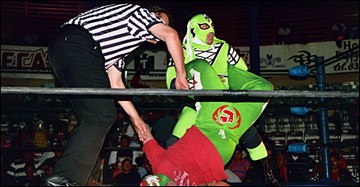Smackdown in Tijuana
Travel Stories: The teeming border city has a bad reputation. But in a rickety arena on a Friday night, Jim Benning discovers the forces of good still have a chance against the forces of evil, at least in swan-diving, chair-slamming lucha libre Mexican wrestling.
08.18.06 | 6:41 AM ET
 Photo by Jim Benning
Photo by Jim BenningIt’s Friday night in a small Tijuana arena, the kind of rickety Mexican structure that can make you misty for American building-and-safety codes, and in the ring before me, masked wrestlers are smacking and flipping and generally abusing one another for my viewing pleasure.
Whap! The great Hijo del Santo goes down. That’s gotta hurt.
The crowd breaks into a sympathetic chant: “San-to! San-to!” I take a gulp of ice-cold Tecate, lean back in my wobbly folding chair (not unlike the ones occasionally slammed onto these wrestlers’ substantial heads) and smile.
While many of my fellow Americans are watching Jack Black play an aspiring Mexican wrestler in “Nacho Libre,” I’ve come south on this balmy summer evening for the real deal: authentic lucha libre—roughly translated, “freestyle wrestling”—the kind practiced by beefy men with such names as El Dyablo who sport menacing masks and, it should also be noted, demonstrate no fear of wearing tights.
It’s an easy trip. My wife, Leslie, and I drive 20 minutes from our home in San Diego until we spot a freeway sign that never fails to stoke my wanderlust: “Last USA Exit.” Veering off, we park in a lot abutting the Mexican border and walk through a creaking turnstile into the other world that is Tijuana.
I know, I know, Tijuana has a bad reputation. The worst. Poverty. Drugs. Crime. Violence. You name it. It’s all true. Just days before my visit, in fact, the heads—and only the heads—of three local police officers turned up in the Tijuana River. It’s enough to make even the most intrepid traveler think twice.
But there’s more to Tijuana than bad news. As I’ve discovered since moving to San Diego two years ago, the city offers plenty beyond the one street that most visitors see, Avenida Revolucion, with its bars, strip clubs and curio shops hawking knockoff “Finding Nemo” beach towels. The scene there, replete with drunken Americans posing for photos atop dejected donkeys painted to look like zebras, calls to mind the famous line attributed to former Mexican president Porfirio Díaz: “Poor Mexico, so far from God and so close to the United States.”
Tonight, we take a cab 10 minutes to Palenque arena at the city’s Hippodrome, where the wrestling extravaganza is scheduled to begin at 8:30.
 Photo by Jim Benning
Photo by Jim BenningOut front, in a sprawling dirt lot, a vendor sells corn on the cob from a steaming pot. A man stands before hundreds of colorful wrestling masks for sale, calling out, “Máscaras, máscaras.” We buy our tickets at a small window—$18 for two bleacher seats, with tonight’s proceeds going to charity—and head inside, savoring the scent of grilling, bacon-wrapped hot dogs. The dimly lit building, with its metal roof and sides, feels more like a tin barn than an arena. We climb a dozen steps and plop down on a long, narrow metal bench.
Radio placards line the ring; beer and brandy ads are plastered across the arena’s walls. The wrestlers are nowhere to be seen, but the party is well underway. Around us, early arrivals are devouring mango slices doused with chili sauce. A boy in a gold wrestling mask nibbles awkwardly on cotton candy through a small mouth slit.
I don’t see many fellow gringos. The crowd appears to be made up of hundreds of locals—husbands and wives, groups of teenagers, fathers carrying masked toddlers. Down below, in a scene that would give an American property manager liability nightmares, two dozen kids have broken away from their parents and commandeered the wrestling ring, flopping on top of one another, swan-diving off the corner ropes, shouting and giggling. I love it.
Around 9 p.m., a bell rings, the kids take their seats and a man in a dark suit announces the first match. Four masked wrestlers (two tag teams) take the ring. As the crowd roars, the men take turns beating, bouncing and flipping one another. One guy pulls a classic Three Stooges stunt and shoots two outstretched fingers at his opponent’s eyeballs. It’s a bold move. The crowd approves.
The men are facing off in a tradition that dates back to the 1930s in Mexico. Like World Wrestling Entertainment in the States, the emphasis is not on serious fighting but on fun, family entertainment, and nothing less than the triumph of good over evil.
Tonight’s bill features four half-hour matchups, each comprising three rounds. After the second fight, those of us in the bleachers are invited down by the ringmaster to fill the more expensive empty seats below. Hundreds of us file down.
By 11 or so, as the final match draws near, I find myself chatting in Spanish with José, a soft-spoken man sitting nearby with his two boys.
Jose tells me that when he was a kid growing up in Mexico City, he attended wrestling matches with his father. Now, living in Tijuana, he often brings his sons.
“It’s part of our culture,” he says. “And we’re aficionados.” Observing the spectators during the evening, I notice that boisterous fathers tend to have loud, screaming sons and daughters. But the opposite is also true. Jos? is quiet throughout the matches, and so are his boys.
Twelve-year-old Iván and 10-year-old Adrián watch intently, even respectfully, rarely making a sound. Iván clutches photos of his favorite wrestlers, including El Hijo del Santo.